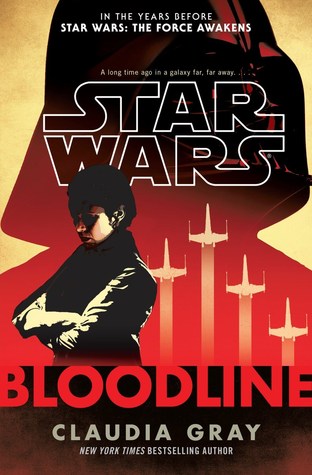Bloodline
Claudia Gray
Release Date: May 3, 2016
Del Rey
ISBN-10: 0345511360
Claudia Gray can tell a Star Wars story.
I got this book from the library shortly before Carrie Fisher fell ill. I had been meaning to read it since its publication and had been looking forward to it since finishing Claudia Gray’s previous Star Wars book “Lost Stars”, a much-beloved novel telling of a romance between an Imperial officer and a Rebellion pilot. I started reading “Bloodline” around the time Carrie Fisher was hospitalized and was reading it when she passed on.
“Bloodline” is emphatically a Leia Organa story, and reading it while the actress who made the character iconic was dying and then being mourned reminded me of what an amazing character Leia is, and it is poignant to realize that her story will likely never be completed on screen. Surely the producers won’t recast the role. Surely?
The Force Awakens set up Leia as a key figure in the ongoing story, and this book supports and explains the film. Leia did not get much screen time in TFA, but was surely intended to be a bigger and bigger part of the story going forward as mentor and commanding officer for Finn, Poe, and Rey; and for her emotional connection to the primary antagonist. Carrie Fisher’s death will undoubtedly require a re-imagining of how that story will develop.
“Bloodline” is a story of Leia’s transition from the end of Return of the Jedi to the beginning of TFA. The universe of new generation films is very different from how we leave RotJ. Where RotJ ends with the destruction of the emperor and the implied destruction of the Empire’s might and the birth of a new golden era of peace and goodness, whatever promise was held at the end of RotJ has been strained or shattered. Leia is no longer with the New Republic, instead directly joining the fight against the First Order while the New Republic does… what, exactly? Apparently nothing. In addition to the failed optimism of the galactic government, Leia’s family life is in tatters. How did the New Republic get to this point? How did Leia?
“Bloodline” tells part of that story. Not all of it, mind, but part of it. The story picks up likely a few years before the events of TFA. Leia is a senator and a war hero, but that only goes so far. The Senate has dissolved into factions. Gridlock and factional suspicion has made it ineffective as a governing force, and planets are grumbling about the rise of large scale organized crime unseen since a certain war hero and her friends took care of the Hutt crime syndicate.
Leia, bored and frustrated by politics and missing the action of her youth spent in the Rebellion, takes it upon herself to investigate a particularly ambitious organized crime ring. In this investigation, she is given a younger partner, Ransolm Casterfo of the opposition “Centrist” party, who she at first considers to be an albatross to hinder her and a barely-closeted unreconstructed Empire-sympathizer. Casterfo is full of surprises however, and Leia comes to respect and even like him.
Without giving away spoilers from the second half of the story, this novel illustrates Leia’s disillusionment with the New Republic (and its disillusionment with her). It also relates the origins of the First Order and how their resources and ambitions were underestimated. We get hints as to how Ben Solo came to be enthralled by the figure of Darth Vader.
Claudia Gray proved in “Lost Stars” that she can tell a rip-roaring story, and she does the same here. The reader never gets bored waiting for the next big advance in the plot, and the secondary characters are drawn well enough to hold the readers’ interest. “Lost Stars” was a much better read than the descriptor, “YA romance told in the Star Wars universe” suggested it had any right to be. “Bloodline”, with its grander ambition, perhaps doesn’t quite reach the level of “greatly exceeding expectations” that Gray’s previous foray into the SW universe reached, but it is an expertly executed narrative and a fun read for SW junkies.
–Richard Pittman


